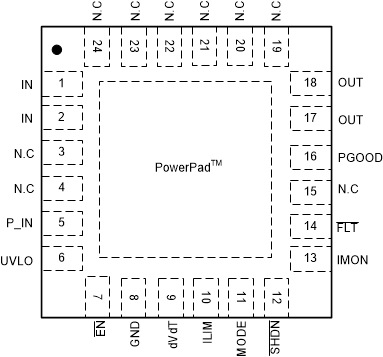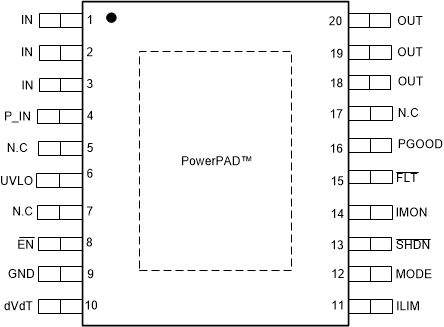ZHCSNE6 August 2021 TPS1653
PRODUCTION DATA
- 1 特性
- 2 应用
- 3 说明
- 4 Revision History
- 5 Pin Configuration and Functions
- 6 Specifications
- 7 Parameter Measurement Information
-
8 Detailed Description
- 8.1 Overview
- 8.2 Functional Block Diagram
- 8.3
Feature Description
- 8.3.1 Hot Plug-In and In-Rush Current Control
- 8.3.2 Undervoltage Lockout (UVLO)
- 8.3.3 Overload and Short Circuit Protection
- 8.3.4 Current Monitoring Output (IMON)
- 8.3.5 FAULT Response (FLT)
- 8.3.6 Power Good Output (PGOOD)
- 8.3.7 IN, P_IN, OUT and GND Pins
- 8.3.8 Thermal Shutdown
- 8.3.9 Low Current Shutdown Control (SHDN)
- 8.3.10 Enable Input (EN)
- 8.4 Device Functional Modes
- 9 Application and Implementation
- 10Power Supply Recommendations
- 11Layout
- 12Device and Documentation Support
- 13Mechanical, Packaging, and Orderable Information
封装选项
机械数据 (封装 | 引脚)
散热焊盘机械数据 (封装 | 引脚)
订购信息
5 Pin Configuration and Functions
 Figure 5-1 TPS16530 RGE Package24-Pin VQFNTop View
Figure 5-1 TPS16530 RGE Package24-Pin VQFNTop View Figure 5-2 TPS16530 PWP Package20-Pin HTSSOPTop View
Figure 5-2 TPS16530 PWP Package20-Pin HTSSOPTop ViewTable 5-1 Pin Functions
| PIN | TYPE | DESCRIPTION | ||
|---|---|---|---|---|
| NAME | TPS16530 | |||
| VQFN | HTSSOP | |||
| IN | 1 | 1 | P | Power Input. Connects to the DRAIN of the internal FET. |
| 2 | 2 | |||
| — | 3 | |||
| P_IN | 5 | 4 | P | Supply voltage of the device. Always connect P_IN to IN directly. |
| UVLO | 6 | 6 | I | Input for setting the programmable undervoltage lockout threshold. An undervoltage event turns off the internal FET and asserts FLT to indicate the power-failure. If not used, this pin can be connected to IN or P_IN. |
| EN | 7 | 8 | I | Active low enable pin. If not used, this pin can be connected to GND. Do not leave this pin open or floating. |
| GND | 8 | 9 | — | Connect GND to system ground |
| dVdT | 9 | 10 | I/O | A capacitor from this pin to GND sets output voltage slew rate. Leaving this pin floating enables device power up in thermal regulation resulting in fast output charge. See the Hot Pug-In and In-Rush Current Control section. |
| ILIM | 10 | 11 | I/O | A resistor from this pin to GND sets the overload limit. See Overload and Short Circuit Protection section. |
| MODE | 11 | 12 | I | Mode selection pin for Overload fault response. See the Device Functional Modes section. |
| SHDN | 12 | 13 | I | Shutdown pin. Pulling SHDN low makes the device to enter into low power shutdown mode. Cycling SHDN pin voltage resets the device that has latched off due to a fault condition. |
| IMON | 13 | 14 | O | Analog current monitor output. This pin sources a scaled down ratio of current through the internal FET. A resistor from this pin to GND converts current to proportional voltage. If unused, leave this pin floating. |
| FLT | 14 | 15 | O | Fault event indicator. It is an open drain output. If unused, leave floating or connect to GND. |
| PGOOD | 16 | 16 | O | Active High. A high indicates that the internal FET is enhanced. PGOOD goes low when the internal FET is turned OFF during a fault or when SHDN is pulled low. If PGOOD is unused then connect to GND or leave it floating. |
| OUT | 17 | 18 | P | Power Output of the device |
| 18 | 19 | |||
| — | 20 | |||
| N.C | 3 | 5 | — | Internally Not connected. Can be connected to other pins (P_IN, OUT, GND) for enhanced thermal performance. |
| 4 | 7 | |||
| 15 | 17 | |||
| 19 | — | |||
| 20 | — | |||
| 21 | — | |||
| 22 | — | |||
| 23 | — | |||
| 24 | — | |||
| PowerPAD™ | — | Connect the PowerPAD to GND plane for heat sinking. Do not use the PowerPAD as the only electrical connection to GND. | ||